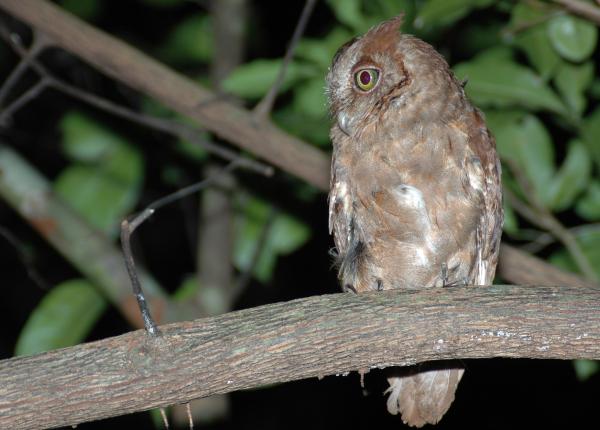How The Peregrine Fund is Helping
The Peregrine Fund has supported the study of the Pemba Scops-owl. Additionally, our conservation efforts through habitat protection, education, and community outreach extend to all raptor species, including this owl. We also supply literature to researchers from our avian research library, which helps scientists around the world gather and share important information on raptor conservation.
Where They Live
The Pemba Scops-owl is found in a small area within the continent of Africa. More specifically, it is endemic to Pemba Island, which is just north of Tanzania.
This small owl prefers woodland habitats and open areas that are dotted with trees with dense foliage. It can also be found in agricultural plantations, often where clove and mango are being grown.
What They Do
The Pemba Scops-owl is one of the smallest scops-owls in the world. This owl comes in two color morphs: the brown morph and the rufous morph. As you may have guessed, brown morph individuals are more brownish, while rufous morph individuals are more reddish in color. But, there is actually quite a lot of overall color variation among individual owls.
Like most owl species, the Pemba Scops-owl is nocturnal - meaning it is most actively hunting, flying, seeking mates, or conducting any other owl business during the night. So, what does it do during the day? When most of us our out and about this small owl takes time to rest, or roost. When roosting, it perches in areas of dense undergrowth, sometimes quite low to the ground.
Why They Need our Help
Like so many other wildlife species, the Pemba Scops-owl is in trouble - mainly due to habitat loss and degradation, particularly because much of its habitat is being converted into open farmland. Of course, this species very limited range doesn't help either. Up until relatively recently, this owl was classified as "Near Threatened" according to the International Union for Conservation of Nature (IUCN). Today, sadly, it now listed as "Vulnerable".
What They Eat
Very little is know about this lovely owl's diet. But, researches believe the Pemba Scops-owl is primarily an insectivore, meaning it feeds on a whole lot of insects! It likely hunts in a variety of ways. It might sit on a perch then pounce onto prey, forage for insects in vegetation, or even capture some flying insects on the wing.
Nest, Eggs, and Young
Though it might be hard to believe, there isn't any really information about the breeding habits or biology of the Pemba Scops-owl. Its limited range, nocturnal habits and dense habitat make it a difficult bird to study. Biologists believe that this small owl probably nests in tree cavities, but this information needs to be confirmed.
Pemba Scops-owl and The World Center for Birds of Prey
Though the Pemba Scops-owl doesn't live anywhere near Boise, Idaho, you can still learn a lot about owls with a visit to our Velma Morrison Interpretive Center at The Peregrine Fund headquarters. The visitor center at our World Center for Birds of Prey includes owls among its avian ambassadors, including a Verreaux's Eagle-owl and a Western Screech-owl. This is a great chance to see owls up close and learn about the wonderful and interesting adaptations they have in order to survive in their respective habitats. There is also a touch table with owl feathers and other natural objects available for exploration.
References:
BirdLife International. 2016. Otus pembaensis. The IUCN Red List of Threatened Species 2016: e.T22688679A93205686. https://dx.doi.org/10.2305/IUCN.UK.2016-3.RLTS.T22688679A93205686.en. Downloaded on 08 August 2021.
Holt, D. W., R. Berkley, C. Deppe, P. L. Enríquez, J. L. Petersen, J. L. Rangel Salazar, K. P. Segars, K. L. Wood, and J. S. Marks (2020). Pemba Scops-Owl (Otus pembaensis), version 1.0. In Birds of the World (J. del Hoyo, A. Elliott, J. Sargatal, D. A. Christie, and E. de Juana, Editors). Cornell Lab of Ornithology, Ithaca, NY, USA. https://doi.org/10.2173/bow.pesowl2.01









